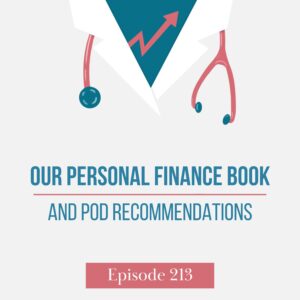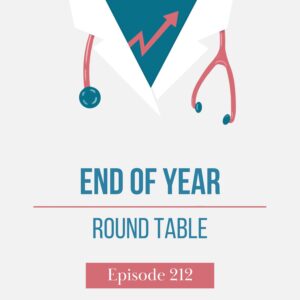Do you get nervous when the stock market goes bad? Where are good places to invest? Discover the power of diversification to conquer volatility and uncertainty.
In this episode of the Finance for Physicians Podcast, Daniel Wrenne talks about diversification of your portfolio in order to keep more dollars in your pockets.
Topics Discussed:
- What’s diversification? Spread money across investments for risk mitigation
- Options/Odds: Should you spread eggs into more baskets to grow a nest egg?
- Benchmark: How to track and measure success with investments in stock market
- ETF Tickers: What to search for/consider for spread of diversification categories
- Cryptocurrency: Is it a good way to diversify? Maybe, too new to know for sure
- Real Estate: Not good way to diversify if actively involved, not passively
Links:
Contact Finance for Physicians
Full Episode Transcript:
Hello, everyone. Hey, I hope you’re having a great day. I was talking with a buddy two days ago and a conversation came up. The same sort of conversation happens with me a lot. The gist of the conversation was, “Oh, you’re in finance?” (This is the guy talking to me.) “Oh, well, I’ve been investing in stocks. I have this one that I’ve been investing in since the stock market went down in the Covid downturn in early 2020.”
He told me this specific stock—I can’t remember now—that he was buying. He wanted to make sure he wasn’t making the same mistake that a lot of his family or friends had made and getting nervous when the market was bad, and instead, invested in something that he felt was a good place to invest. He proceeded to tell me about his experience investing in this stock.
It did very well a year or so after, but lately it hadn’t done as well. That’s kind of what brought up (I think) his thought about this stock, is he was asking me about how we’re handling the recent market volatility, which is a common dinner party conversation or question people ask me.
This stock in particular he was describing, he was sharing, has been doing not so well, but he was still optimistic about it. Over that period of time—March, April, May of 2020, till now—it’s still above breakeven, so he’s still made some money on it. Overall, he felt pretty good about it, especially given the weak market that we’re in now. As I’m recording this, this is close to them. It’s early May 2022, and the market’s been a little shaky. Given the market uncertainty, he felt pretty good about it.
That is a conversation I’ve had too many times. I can’t even remember how many times I’ve had it with people usually at social events. They’re sharing about their experience in investing. Generally, it’s a favorable lien. This example I just gave was kind of a little bit of a negativity creeping in but still overall favorable. It wasn’t like they were asking my advice or opinion. They were trying to make conversation with me, knowing what profession I was in.
I’m sure you all have had similar conversations about your profession as it comes up. After having that conversation and just seeing it come up so many times, I thought it would be good to talk today about diversification and this temptation for the opposite of that, the FOMO temptation or the shiny object. We’re all susceptible to it.
I don’t know. Maybe you’ve had a better experience. But most people I talked to—including myself—had examples of situations where we probably made a poor decision, went away from diversification, and went after the shiny object. I fortunately learned a lot of those lessons earlier when I was younger, when the dollars weren’t as big.
I think a lot of the questions normally come up are like, how do I avoid this? I think the key here is—at least from a starting point—is education. Educating yourself, that’ll go a long way. It’s not everything, but it’ll go a long way. Just understanding the basics of how this works and how it plays into the results and your situation, I think that’ll get you a long way.
What we’re going to do today is just talk about some baseline education along the lines of investing, foundational investing, and diversification in particular. Hopefully this will help you keep a little more dollars in your pocket in the end.
Okay, so what is diversification? Let’s just clear that up real quick. When I say diversification or the definition of diversification would be spreading your money across multiple investments in an effort to reduce volatility and risks. I’m sure you’ve heard that before, spreading your eggs in different baskets. It’s a risk mitigation tactic. Ultimately, the goal is to be more efficient with your investments.
Let’s assume you had $10,000 and you want to invest in some company stocks. You want to put it to work for you. Hypothetical example, let’s just say each company has exactly a 1/3 chance of going completely bankrupt. You got a choice of stocks, each company has 1/3 chance of going bankrupt, and then the remainder of the companies, so 2/3 are going to do really well. But the catch is, you have no idea which one will be which.
Option one, maybe you take $10,000 and you buy one stock. You just pick one, I don’t know. Since you don’t know who’s going to do what, you are just flipping a coin, basically. In this scenario, 1/3, obviously, chance of losing it all, 2/3 is the chance of doing really well, which sounds okay (I guess) if we’re thinking from a casino kind of viewpoint.
It’s better than Blackjack. It’s better than going to the track or a roulette, but probably not adequate for your retirement. Most of us would agree, I think, that that’s probably unreasonable for a nest egg and trying to build it, because a 1/3 chance of losing it all is just too much risk.
Let’s say option two is you buy $1000, so you spread your eggs in different baskets by 10 stocks, $1000 each. In that scenario, by spreading it out into 10 different stocks, you decrease your chances of losing it all by a ton. I think it’s like one in 60,000 or something like that, like one in tens of thousands chance of losing it all. A pretty small chance of losing it all just by spreading it out into 10 different stocks. So that’s good.
Maybe even option three, you buy $100 and 100 stocks. That makes it incredibly small chance. It’s basically pretty close to zero, but there’s a tiny chance you’re going to lose it all. The concept of diversification is you’re spreading out the investment so that you’re reducing those chances of having poor outcomes. There are some issues people run into that make it a little harder to diversify, so we’ll circle back to that. But that’s diversification.
I’m sure you’ve heard the market thrown around, the word the market, and I’ve probably thrown it around a bunch of times before. I wanted to clarify that since we’re going to be digging into this a little bit more. When I say the market, the market is the collective of all companies you can invest in.
Anyone can invest in them. They call them public. That means anyone can buy stock in these companies, whether they buy it directly through directly ownership of the stock, or maybe they buy an ETF that has that company stock in it, or maybe even a mutual fund. When you hear the market, that’s the collective of all the companies that are able to be purchased by anyone through any of those vehicles.
When you look at the market overall and you kind of like smoosh it all together, it’s actually a pretty solid investment in itself. At a minimum, it’s a good benchmark for how are you doing. Sometimes people struggle with knowing how to measure success in investing, because it’s like, well, what’s the alternative?
One really good example of an alternative or a benchmark to compare would be the market where all stocks that are available. There are a bunch of different measures of the market. There are even stocks that track the market, like the Vanguard Total Stock Market. That’s meant to be a pretty good representation of the total US stock market, or the Total World Index or something like that.
There are mutual funds and ETFs that track the market. In other words, their intent is to own all the stocks. That’s a good kind of benchmark for what are we tracking against for buying stocks. Nowadays, it’s pretty easy, or I guess easy and inexpensive to buy the entire market.
Or you can buy slices of the market, too. That’s where it starts to get complicated. You can buy small companies, you can buy tech stocks, you can buy everything in between—an individual stock and owning the entire market. But when I say the market, I’m talking about owning everything, just owning all the stocks in the market.
The other thing I wanted to point out is, with diversification, one of the primary goals is to reduce risk. I think it’s good to clarify, there are a couple of different categories of risk. There is systematic risk in investing. That’s the stuff you can’t get rid of from diversification, the market risk.
It doesn’t matter how many eggs you have in different baskets. You could own a million stocks or all the stocks in the world, and you’re still going to have market risk, either the market itself, inflationary issues or stuff like that. There are some stuff that we just can’t diversify away from. Those are just there, that’s a baseline. Systematic risk, you can’t really get rid of it. It is what it is.
This stuff, though, with diversification, we’re trying to reduce or even avoid. They call it unsystematic or idiosyncratic risks. This is like the non market risk. This is what you can reduce by diversification.
Examples of that would be company-specific risks. Every company has risks, whether it be having a bad CEO that nobody realized, or a lawsuit, or a product that just doesn’t work out. Those are things companies cannot always avoid. They’re going to always be there. Sometimes they’re completely unpredictable.
There are industry-specific risks, like big regulatory change related to an industry or just market factors. The pandemic had more negative effects on the entertainment industry. Those types of things are risks, too, but you can diversify to help reduce them.
Back to the pandemic, like I was saying, entertainment companies were much more susceptible to that risk. If you had one stock, let’s say you had Carnival, all your money was in Carnival, that would be a problem when the pandemic hit, because they’re getting crushed. Even if you had all cruise liners, all their stocks, and even all casinos and all the entertainment industry, you’re still getting a huge hit when the pandemic hits, like major. What diversification does is you’re going to be owning multiple different industries and diversifying away from that risk, so that it’s softening the blow, basically.
The stock market, when we look at this market, I think it’s good to look at history doesn’t always repeat itself, but it’s really the best thing we have to understand things and how they work. Going back to that market, I’m talking about the market overall.
For this example, I’m going to talk about the S&P 500. That’s one measure of the market. What that technically represents is this 500 biggest companies in the US. It’s definitely not a complete measure of the entire market, but it’s a pretty good slice of the market, so S&P 500. We’re going to look at this a little bit to understand how this works.
Historically, what tends to play out is a pretty small percentage of companies end up influencing the performance of the overall market. In other words, the big winners pull up the rest of everybody else. It’s substantial. I found some statistics on this. It was surprising even to me. The statistics were on the S&P 500.
From 2000 to 2020, the majority of stocks underperform the S&P 500 returns. The S&P 500, of all those 500 stocks, the majority of them are underperforming basically the collective return of all of them. The percentage of those, some do over outperform, but the percentage that does outperform is 22%. Basically, it’s 80/20 roughly, 80% underperform, 20% over outperform over that period of time. Those 20% are basically pulling the weight there.
Another view of that is over that same period of time, the S&P 500 gained 322% while the median stock rose by just 63%. Basically, the takeaway there is only 20% of the stocks are really outperforming. Then the average stock, if you just pick a stock, there’s a very good shot it’s underperforming. Picking stocks randomly has a very high likelihood of underperformance.
You might be asking like, well, okay, why not just pick the winners? How hard can it be? It’s actually super difficult. The more you dig into this, you’ll start to see this. If you look at all the research on this, even for the investing pros or experts, it’s extremely difficult for them to pick those winners.
We talk a lot about this. I’ve done some shows in the past on passive investing, so we’ll link to those. We dig into that a little bit more. Basically, having the winners or having those stocks that do really well in the past, it’s been like Amazon and Apple. Those stocks have killed it. Having them in your portfolio or in your basket of stocks is pretty huge for a long-term success, but they’re really, really hard.
On the back end, they’re easy to pick. But on the front end, they’re very difficult to pick, even when you are super smart and do tons of research. Diversification is basically saying, I’m going to buy multiple stocks, many stocks maybe, maybe a ton of stocks, to help reduce my risks of underperforming the market.
Now in passive investing, I mentioned that already. Passive investing is not exactly the same thing as diversification. Passive investing is more like a style of investing, approach, or philosophy. Passive investing is like the ultimate of diversification, which I’ll link to that. If you’re not clear on what that is, you can dig into that. Passive investing is a good example of diversification because it’s basically owning everything.
Let’s look at a market-specific example. You could buy Zoom stock. I was looking at it. I was using Zoom, so it popped into my head. Zoom stock has done really well. Also, people have asked about it or looked into it.
If you look at Zoom stock, and I just pulled it up for a year, it’s not that you should look at a longer period of time, but the concept I think I wanted to make it’ll be good for it. I just pulled up Zoom stock on Google Finance. The one year return as of when I’m looking at it now, which is May 2nd, 2022, and this is on Google Finance, was -67.02%. It’s had a rough year or 12 months ending today. I guess this is as of the minute.
Google Finance is pretty cool because they have a very good tool to look up stocks, securities, and mutual funds. You can just type in the ticker, or Zoom stock quote, or whatever, and it’ll go straight to that. I think it’s showing you the return one year as of the most recent quote today, so it’s changing. It’s already down. It’s 66.82% now. It’s changing as I’m talking, which is funny. Anyway, it’s way down, it’s 60%+ down, we’ll say, over that one year period of time, which is pretty lousy. Obviously, that’s a killer.
Now if you look at the Vanguard Information Technology Fund (VGT), that’s a good kind of tech sector. It’s more of like a big basket of technology stocks. That’s a really good example of company diversification, not sector diversification, because you’re just buying a tech ETF. It’s just a bunch of tech stocks.
If we’re comparing Zoom stock and we look at a technology sector ETF—I’ll use this ETF called QQQ. It’s basically a pretty good slice of the technology sector or whatever—it’s not nearly as bad. It’s down, I guess. As of one year, it’s like 6% or so down.
When you compare those two, it’s much less volatile. Basically, you’re owning the entire tech sector. You’re diversifying away from that company-specific risk. I’m not sure what’s happening with Zoom, but they’ve had a rough stretch, obviously, since after the pandemic. Before the pandemic, they had a big upturn, but since then, they’ve had some downturn. Owning a technology sector ETF is going to be a way to diversify away from that company-specific risk.
And then you can go further with it. You can say, okay, well, if diversification is helpful, why not own all the different sectors so you can buy the Vanguard Total Stock Market. For investing in the US, that’s very well-diversified. Basically, the intent is to own the entire US stock market, so it’s going to own all the sectors.
Since you’re able to diversify not only away from those company-specific risks but also industry-specific risks. It’s the best way to reduce that unsystematic risk and ultimately will provide better outcomes.
If you’re on board with that approach, I think the common question is, how do I actually do this? I think the first thing is to look at what you’re investing now. Also, on top of educating yourself on just this, you can dig into this concept a lot more. I’m still scratching the surface.
It’s good to educate yourself on the topic, especially if you’re not familiar with a lot of this stuff. But once you feel good about it, you start to look at your specific situation and understand what your overall percentage of types of investments looks like. They call it asset allocation. What percentage of your total investments are in stocks or bonds? What types of stocks do you have? Do you have technology stocks? Do you have real estate? Do you have whatever? Are they big companies or small companies? That’s a simple thing, understand your asset allocation. That’s a good small step to see how you’re doing on this whole diversification thing.
You might be thinking, how do I do that? An easy way to do that, it depends on what you own, but hopefully you own either ETF, a mutual fund, or a stock. If you own a mutual fund, ETF, or stock, it has what’s called a ticker. That’s a letter abbreviation of the fund. You can google it. That’s probably the easiest way.
Let’s say you own VTI, that’s one of the biggest ETFs. You can google VTI. Click into Vanguard and it’s going to have pretty good info. Let’s do this. I’ll show you a good way to do it that’ll work for any type of ETF stock or mutual funds.
You can go to a website, morningstar.com. Morningstar is nice because it’s a free to the public website. Anybody can get on it. Go to Morningstar. At the top, it has search quotes on it. You can type in VTI or if you’re not sure what the ticker is, you can type in Vanguard Total Stock Market, and then you just have to pick whether you have an ETF or something else.
If you have the Vanguard Total Stock Market ETF, you click that. That’s going to pull up their summary of that particular fund. You can click on to portfolio. When you scan down a little bit, you’ll see a tab for portfolio. That’s the one to look at, I think, if we’re talking about how well it’s diversified.
I’ll show you a few helpful things to look at. If you go scan down a touch, you’ll see on the left asset allocation, and on the right, stock style. The asset allocation will tell you how much of it is US versus international versus fixed bond–type investments.
This investment, the Vanguard Total Stock Market, is basically 100% close to 100% US stocks, which makes sense. Now on the right side, stock style, you can see this map. I like to click weight, switch it to weight. You’ll see that’s the percentage of each category that you have. I don’t know what they call this thing, but it’s nine boxes showing which.
If you look at the top left, that’s basically showing you own 15% large cap value. Those are larger companies that are categorized as value companies. That’s one of the things you can categorize by when you’re looking at diversification. Then medium is in the middle and small is on the bottom.
For diversification purposes, you’re looking for a general spread across this. You definitely don’t want any one of these categories. That’ll show you the size, spread, and the value versus growth spread. Then you can scan down a little bit more. Scan down to exposure on the left and sector. You can see what percentage this particular ETF owns between technology, financial services, real estate.
This ETF owns 25% in change of technology stocks, and then it owns 13%, financial services. Then three, almost 4% real estate. A lot of people don’t realize they own real estate within their fund. You want this to be spread out.
You can look at all this stuff, but the last big thing I typically take a peek at is holdings right below that. You can see equity holdings listed there as of the most recent date. This particular fund as of March 31st, 2022, has 4119 equity holdings. That basically means this fund, when you buy it, you’re going to basically own over 4000 individual stocks, which is great. You want a high number there. If you’re looking to diversify, you want a big number.
Some of these mutual funds have 50 or less stocks. That’s much, much less diversified. If you’re going for diversification, higher numbers are generally better. It’s also interesting. Sometimes, if you’re curious more specifically, below it, it’ll show the holdings. A lot of people don’t realize they own all these stocks, like you’re going to own Apple almost 6% in this fund.
You can look at each of those funds that you own and see where it’s invested. You can do a spreadsheet and say you own four funds, and you have the dollar amount, and then you can plug in which asset class each of them have, and how many securities they have. All those metrics I just pointed out, you could map that out on a spreadsheet, and then pull that all together. There you have it, you’re going to have a very good view of how you’re invested, how well it’s diversified, what your asset allocation is, all those sorts of things.
That’s a good exercise, especially if you’re doing this yourself. This is the way you really want to be. If you’re working with a planner or if you’re working with us, it’s more of making sure that’s something that’s being addressed and understanding it, or asking questions, or having the education level to know good questions to ask, that sort of thing.
Any of you guys that work with us, feel free at anytime, bring this up and we can dig in as much as you’d like. It’s good either way, I think, to understand the basics. If you need to make changes, say you go through this and maybe you own three stocks or something, if you own three individual stocks, I think it’s obvious. It will probably be a very good idea to diversify, own maybe more than three because you just don’t really know.
You have to be careful with it in some instances. Don’t just sell everything and go buy new stuff. Make sure you’re keeping an eye on the tax consequences. That’s one thing, especially if you have it in a taxable investment, if it’s not in a retirement plan. There can often be tax consequences when you sell things. Just be aware of that. Talk to your accountant or talk to your financial planner before you just go selling stuff.
If you’re working with those people, lean on them. That’s the big thing. It’s saying, what does my asset allocation need to look like and am I in line with that? That’s really what it comes down to. How well am I diversified? It would be good to see that. Then, what are the categories of how it spread. Is that as efficient as it needs to be? If you need to make changes, you’re just making changes over time.
A lot of people have anti diversification, I guess. I don’t know. At least, maybe they don’t say it that way, but a lot of this stuff that’s out there is against diversification. Some of the questions we see come up, I wanted to throw out and talk over briefly.
I’ve heard the question posed of, is diversification going to make it harder for me to hit goals? Maybe I’m not going to hit any homeruns, because diversification is hitting a single and a double. It’s like a base hit. The question would be, well, maybe I want to go for homeruns because striking out is bad, but if I go to bat enough times, it will eventually work out good. With investing, that’s not really true.
I’m talking to a group of you all. There’s maybe one of you. I’m sure there’s someone you’ve talked to before that hit home runs and just crushed it with not diversifying, like picking winners. But if you look at large numbers of people, even super smart people that know what they’re doing, it’s incredibly difficult to do well not diversified or just hit a home run.
Since I’m talking to a group of you all, no question. Diversification is actually going to make your goals easier to hit. One of you might get lucky, or whatever, or hit that home run, but the bulk of you all will be better off by diversifying, actually. It will make it easier to hit those goals.
It’s common to hear this from a buddy that just had something good happen. It’s like, my buddy just bought Gamestop stock, so I want to try it out, too. Before you go about doing something based on a contact or a friend, consult with the research. Do some homework. Odds are, your buddy doesn’t really know what he’s doing. He just got lucky.
It’s not like winning the lottery lucky. If your buddy made some money buying stocks, that’s not like going to the track and hitting it big, or winning the Powerball or whatever. It’s more like speeding and not getting caught. If you speed enough, you’re going to get pulled over, but not everybody. You know the person that just has not gotten caught and you’re like, dude, you’re going at 50 over.
The researchers would all agree that would be luck. A lot of it is luck. There’s always going to be that person, though, that hits a home run, even though it is luck.
Another question that comes up is, is cryptocurrency a good way to diversify? Cryptocurrency is interesting. It’s still so new. We covered it a while ago. I’ll link to that in the show notes. It’s a very new thing. The verdict is still out as to how that’s going to shake out. I guess you could call it maybe a sector, but it’s not a traditional investment in the sense of there’s no underlying business.
You’re investing in a currency-ish. It’s more in the category of currency or really, I guess, NFTs (non-fungible tokens), those types of investments. It’s a very new type of investment. There’s a lot of uncertainty. The verdict is still out. I guess it could be a potential new way to diversify because the diversification works really well when you find different things you don’t already own and you own them as well. Cryptocurrency could be an additional way to diversify, but I’m not sure of that yet. I think it’s really early and I think time will tell.
What about diversifying into passive investments like real estate? That’s a question that comes up a lot. It’s like, I get the whole diversification thing, so let’s take it to the next level and let’s diversify into my local real estate market. It makes sense on the surface, but in reality, that’s actually going the other direction, away from diversification.
Most people already own real estate. They don’t realize it, but they own real estate in their investment funds, like within their investment funds. Like I was talking about earlier, the Vanguard Total Stock Market owns real estate. Most people already own real estate, they just don’t realize it. Most people own it as passively as you can own it, which is just in a fund.
What I mean by the other direction, if you’re picking one particular market, in one particular city, in one particular type of real estate like long-term rentals, and you’re deciding to invest in that, that’s the opposite of diversification. That’s picking one stock. It’s like going all in one specific direction, as opposed to owning all sorts of real estate.
The difference between owning real estate like this, like I’m talking about, like directly owning it, is that you are more actively starting to participate in the business. That’s a little different. I think the same question comes up sometimes. It’s like, what if I’m investing in my business? That’s different because you’re involved in it.
At least in my view, I’m a huge fan of diversification. The exception I give is for my own business, really. That doesn’t mean I’m not going to diversify my business, but I am okay not being nearly as diversified in my own business because I’m directly involved in it. I have my finger on the pulse. If I’m going to go away from diversification, it’s going to be in something I’m actively involved in, as opposed to just picking a stock that I have no involvement with.
All right, that’s diversification. I know we can go a lot of different directions with this. I’ll leave it up to you guys. If you want to dig into different topics or go different directions on this, feel free to reach out. I appreciate the questions you all been throwing out. I’ll continue to take those in, and as they come up we’ll cover those topics. All right, as always, good catching up. We’ll see you next time.









